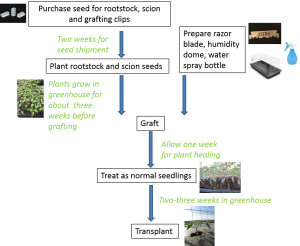There are several potential benefits of growing grafted tomatoes, particularly for early season tomato production in greenhouses or high tunnels. If you are interested in trying this technique but wondering whether it is possible to graft tomato plants by yourself, a Purdue extension publication, Techniques for Tomato Grafting, (https://extension.purdue.edu/extmedia/HO/HO-260-W.pdf ) provides a step-by-step guideline for small growers to explore this technique.
A question I am often asked is: when should I start to plant the seeds to produce grafted plants? The chart below shows a general timeline and materials needed for producing grafted tomatoes on a small scale on your farm. As a general rule, the grafting process delays seedling growth for 6-7 days. The delay normally does not make a noticeable difference on the size of seedlings after the grafted plants are grown in a greenhouse for more than 2 weeks prior to transplant. As a matter of fact, grafted plants could potentially grow faster than normal transplants after they are fully recovered, assuming cell size does not limit their growth. With that said, there is no need to start seeds much earlier than you would normally start seed.

Figure 1. A general timeline and materials needed for producing grafted tomatoes on a small scale on your farm.
Seed companies now provide several tomato rootstocks. It is nice to have choices, but it is not always a good idea to have too many choices for a beginner. If you are new to tomato grafting, and your primary aim is to increase yield instead of controlling soilborne disease, my recommendation is as follows: use the rootstocks that are most readily available. Maxifort might be a good choice to start with simply because it has been on the market for several years and there is lots of research data to support its performance. Under certain conditions, Maxifort rootstock might make tomato plants grow too bushy because of its vigor, and it is true that some of the newer rootstocks may be able to address this challenge. Several other factors such as tomato variety, fertility, pruning and trellis technique also affect the balance between vegetative growth (grow leaves and shoots) and reproductive growth (setting fruit). It would make more sense to explore different types of rootstocks after seeing how the grafted plants perform under your normal production systems.
It is important to note that grafting will not control foliar diseases. As a matter of fact, because grafted plants tend to grow more vigorous than normal plants, they are more likely to create a microclimate condition that is suitable for the development of foliar diseases. Therefore, giving plants plenty of space, timely pruning and trellising, as well as maintaining a good air flow is more critical when growing grafted plants.
If you have questions about tomato grafting and growing grafted plants, please do not hesitate to contact me at guan40@purdue.edu, 812-886-0198.